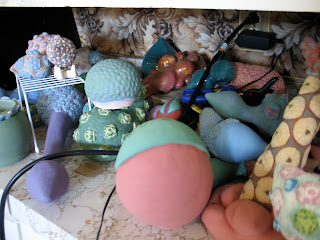Art Appreciation students: Looking for the link and videos mentioned in class Friday? Scroll down the the previous post.
It's been a busy week, I guess. I prepared this post last weekend but didn't have a chance to post it.
This week we had a clay sale at YVCC. We did well, though I notice that the crowd has been more docile in the last couple years. Back when I started (6 years ago), people would be hovering over their intended targets for 10 minutes before the sale started. This quarter we did have a few hover-ers but they were calm and patient.
The sale was on Thursday and that evening the school had a halloween dance. We had a few randomly bloody students hovering around the sale. One appeared to be a blood turtle. Another had blue painters tape on his face (Does anyone know why?).
We also loaded our first glaze kiln this week and, apparently, ran out of all the glaze materials in the studio. I really need to place an order for some cobalt oxide and some tin oxide.
the kiln mostly loaded. the tall extruded forms worry me a bit, I'm afraid they will fall when I push the car into the kiln.
I will fire the glaze kiln Monday during our assessment workday. There are no classes but I will be on campus anyway. On Tuesday I will be giving a lecture/demonstration to an art class at David High School. We will unload the kiln that afternoon or the next day (depending how excited my independent students are to see the results).
Last weekend, before the busy week in the school clay studio, I got some work done in my home clay studio. I've been wanting to put away my underglazes so I can regain most of a countertop on which to work. (I'd also like to clean out the dead bugs from the windowsill behind the counter.) But before I put away the underglazes, I wanted to improve my inventory system.
Fired underglaze colors are very close to what they appear when they are applied, but not exactly the same. They also can change a little depending on how thickly they are applied and whether they have glaze over the top. Firing changes (like firing glazeware and bisque at the same time) can have an impact too. I wanted a chart of fired colors so I could quickly double check which blue I was intending to use when I went to put on a touch-up coat after firing. So I made these:
Each basic underglaze color has its number painted on in 3 coats and then a set of three lines (top=one coat, middle=two coats, bottom=three coats). These took me most of nap time, but my counter is clear (and mostly free from dead flies).
stack of underglaze bottles halfway through inventory
stack of bottles after entire inventory completed
I also epoxied my work from summer. I had a plate that needed a sprig glued back on and a couple pieces with other damage. I wanted to attach hanging equipment on the back of a couple pieces I might use for this winter's installation.
the center piece has a hanger inside (underneath); the back left piece has a washcloth holding the epoxied hanger.
I use PC-7 for my repairs. I try not do do a lot of repairs but I find the PC-7 works well when I need to fix something. The texture is like a past and I can fill in gaps and build the surface up a little bit. The epoxy hardens in 24 hours so I have plenty of time to work with it. The only disadvantage is that it the repair needs to be supported and immobile during that time. I occasionally use 1-minute epoxy to make repairs that aren't visible so that I can hold the pieces together as the epoxy hardens. In general I don't like the look of the shiny clear epoxy.
This weekend I took some work to several galleries for holiday shows. I took work to Oak Hollow Gallery near Inklings in Yakima and to Allied Arts on Lincoln in Yakima. Today I brought work to Gallery One in Ellensburg. I brought some functional work and small work to both the Yakima galleries. I was a little disappointed after I dropped the work off because I don't think of the small stuff as my "main" work.
I appreciate that people like my bowls but I don't want that to become the main work I do. I did bring bigger stuff to Gallery One and a couple medium pieces to Oak Hollow. These holiday shows are about sales, not so much about showing the work.



































